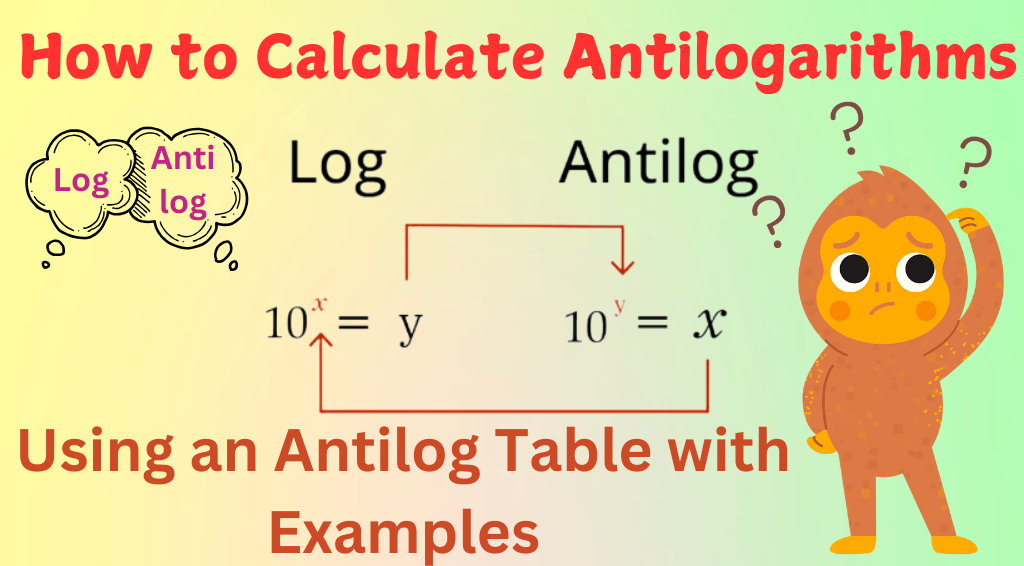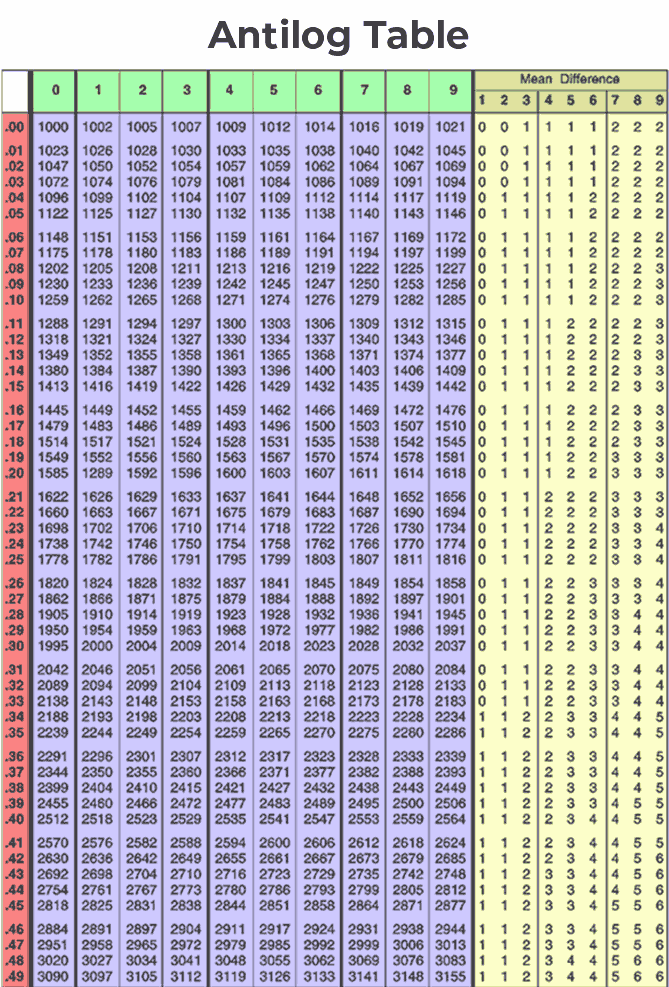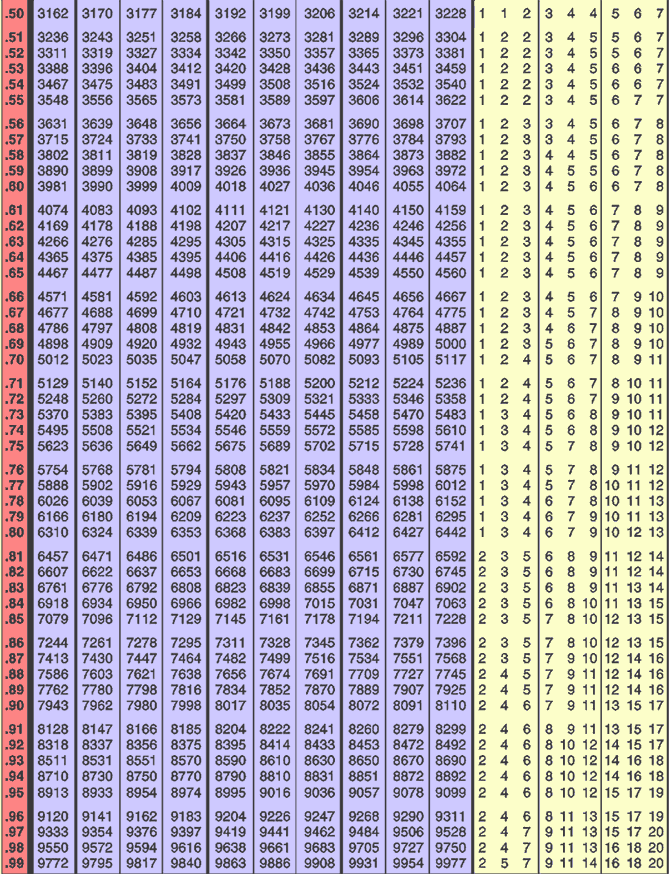How to Calculate Antilogarithms Using an Antilog Table with Examples
How to Calculate Antilogarithms: Antilogarithms are the reverse of logarithms. Learn steps to calculate the antilog of a number using an antilog table in this blog.
Antilog Table: Before calculators and computers, people used antilog tables to solve problems involving logarithms and exponents. These tables made it easier to calculate large or small numbers without doing complex math by hand.
How to Calculate Antilogarithms
How to Calculate Antilogarithms Using Antilog Formula?
Before calculating the antilog of a number, it’s important to understand the two components of a logarithmic value: the mantissa and the characteristics. These parts are fundamental to the process.
The mantissa is the decimal (fractional) part of the logarithm. It represents the fine detail of the logarithmic value and is always positive, regardless of whether the logarithm itself is positive or negative.
For example:
- In log(500)=2.698, the mantissa is 0.698.
- In log(1000)=3.0, the mantissa is 0.
- In log(0.01)=−2.0, the mantissa is 0.
The characteristic, on the other hand, is the integer part of the logarithm. It represents the magnitude or order of the number relative to powers of 10.
It can be positive or negative, depending on the number’s size.
How to Calculate Antilogarithms
For numbers greater than 1, the characteristic is determined by counting the digits to the left of the decimal point, minus one.
Example 1: log(500)=2.698. The characteristic is 2 because there are 3 digits to the left of the decimal in 500, and 3−1=2.
Example 2: log(1000)=3.0. The characteristic is 3 because there are 4 digits to the left of the decimal in 1000, and 4−1=3.
How to Calculate Antilogarithms
For numbers less than 1, the characteristic is calculated by counting the zeros immediately following the decimal point, negating this count, and subtracting one.
Example 1: log(0.01)=−2.0. The characteristic is −2 because there is 1 zero after the decimal in 0.01, and −(1+1)=−2.
Example 2: log(0.001)=−3.0. The characteristic is −3 because there are 2 zeros after the decimal in 0.001, and −(2+1)=−3
Together, the characteristic and the mantissa provide the complete logarithmic value.
To calculate the antilogarithm (inverse logarithm) of a number, you need to separate the logarithm into its characteristic (integer part) and mantissa (fractional part). The antilogarithm is then calculated using the formula:
x= 10log(x)= 10Characteristic+Mantissa
How to Calculate Antilogarithms
Let’s take an example to clearly explain this process.
Example 1: Find antilog (2.4567)
Step 1: Break the logarithmic value into the characteristic and mantissa
- Given log(x)=2.4567
- Characteristic = 2 (the integer part).
- Mantissa = 0.4567 (the fractional part).
Step 2: Use the antilogarithm formula
The antilogarithm can be expressed as:
x=10log(x)=10Characteristic+Mantissa
Which we rewrite as:
x= 10Characteristic × 10Mantissa
Substitute the values:
x=102×100.4567
Step 3: Calculate each term
- 102=100
- 100.4567= 2.8622
Step 4: Multiply the results
Now combine the results:
x=100 × 2.8622=301.6
The antilogarithm of 2.4567 is approximately 286.22.
How to Calculate Antilogarithms
Example 2: Find antilog (4.5234)
Solution:
To calculate the antilogarithm of 4.5234 using the antilog formula, follow these steps:
Recall the antilog formula:
antilog(x)=10x
Given logarithmic value:
x= 4.5234
How to Calculate Antilogarithms
Break x into the characteristic and mantissa:
Characteristic = 4 (integer part).
Mantissa = 0.5234 (decimal part).
Using the formula, rewrite x = 4.5234 as:
104.5234=104×100.5234
Calculate 104:
104=10000
Calculate 100.5234
Use a scientific calculator or exponential function to compute 100.5234
100.5234≈3.34210
Multiply the results:
104×100.5234 =10000×3.342=33420
Steps to Calculate Antilog Using an Antilog Table
To calculate the antilog of a given logarithm using an antilog table, the process involves breaking the value into its characteristic and mantissa parts.
Let’s go step by step to find the antilog of 2.6452 using an antilog table:
Example 1: Calculate the antilog of 2.6452
Step 1: Separate the characteristic and mantissa
The given logarithmic value is 2.6452
- Characteristic = 2 (integer part).
- Mantissa = 0.6452 (decimal part).
How to Calculate Antilogarithms
Step 2: Use the antilog table for the mantissa
Refer to the antilog table:
- Look for the row 0.64, which represents the first two decimal places of the mantissa.
- Then locate column 5, which corresponds to the third digit of the mantissa (0.645).
- The value found at row 0.640, column 5, is 4416.
Step 3: Use the mean difference for the fourth digit
- The fourth digit of the mantissa is 2.
- Using the mean difference columns in the same row, 0.64, find the value for column 2.
- The value corresponding to this is 2.
How to Calculate Antilogarithms
Step 4: Add the values from steps 2 and 3
4416+2=4418
Step 5: Insert the decimal point
- To determine the decimal point’s position, add 1 to the characteristic (2+1=3).
- This means the decimal point will be placed after the third digit from the left in 4418
Result: 4418→441.8
The antilogarithm of 2.6452 is approximately 441.8.
Example 2: Calculate the antilog of 2.7845
Given logarithm: 2.7845
Characteristic: 2
Mantissa: 0.7845
Find the value for the first three digits of the mantissa (0.784):
Locate row 0.78 and column 4 in the table.
The corresponding value is 6081.
How to Calculate Antilogarithms
Adjust for the fourth digit (5) using the mean difference:
In row 0.780, locate column 5 in the mean difference section.
The mean difference value is 7.
Add the base value and the mean difference:
6081+7 = 6081 + 2 = 6088
Insert the decimal point:
Add 1 to the characteristic (2+1=3).
Place the decimal after the third digit: 608.8
The antilog of 2.7845 is 608.8
How to Calculate Antilogarithms
Difference Between Antilogarithm and Logarithm Tables
Antilog and log tables are mathematical tools used to simplify complex calculations involving exponentials and logarithms. While both serve as reference tools for manual computations, they perform opposite operations and are used in different scenarios. Below is a detailed comparison of the two:
| Difference Between Antilogarithm and Logarithm Tables | ||
|---|---|---|
| Aspect | Antilogarithm Table | Logarithm Table |
| Definition | A table is used to reverse a logarithmic value, helping retrieve the original number from its logarithm. | A table that provides the logarithmic value of a given number, typically to base 10 or base e. |
| Purpose | Converts logarithmic results back to their original form (inverse of logarithm). | Simplifies calculations by converting numbers into logarithmic scales. |
| Content | Lists numbers corresponding to exponential values derived from logarithms. | Contains the logarithmic values of numbers for commonly used bases like 10 or e. |
| Usage | Used to perform operations involving exponential calculations or reverse logarithms. | Used for simplifying multiplication, division, or handling very large or small values. |
| Example | If log10(x)=0.301, the antilog table gives x=100.301≈2x | If x=100, the log table gives log10(100)=2 |
| Applications | Commonly applied in exponential growth, decay problems, and scientific data modeling. | Widely used in fields like engineering, mathematics, and science for dealing with orders of magnitude. |
Antilog tables were once the go-to tool for solving tricky calculations involving logarithms and exponents, making seemingly impossible math manageable.
While modern technology has taken its place, learning about antilog tables is still fascinating. It connects us to a time when precision relied on skill, and understanding their use can sharpen your grasp of logarithmic and exponential calculations.
How to Calculate Antilogarithms
Read Also – Surface Area Formulas: Definitions, Derivations, Examples

My name is Khushi, I am a content writer and I provide news related to government jobs and I am from Rajasthan and I only write on this website.



